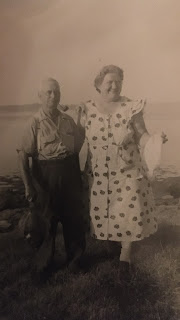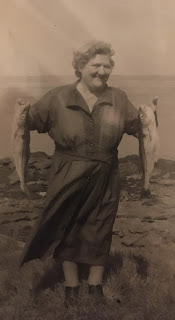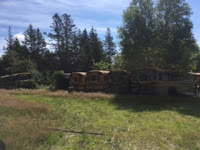It wasn't the hip village of the musical "Rent" then -- the one in which I came of age as a young adult working at the #Village Voice from 1985 - 1998.
Yet it WAS "La Vie Boheme" quite literally in regard to my great grandparents, Frantisek Urban and Aloisie Herel, who landed (separately, before meeting and marrying two years later) on the Lower East Side, along with thousands of other immigrants from Eastern Europe and beyond, fresh off the boats from Bohemia in 1892.
Mary and her two older brothers, Joseph and Frantisek, Jr., were born in that Avenue A apartment. They grew up speaking Bohemian. Frantisek was a butcher in the city. At some point, between a trip back to Czechoslovakia in 1900 and the birth of their fourth child there, Rudolf, and the 1910 census they relocated to Killingworth, CT and became a farming family on their own small farm.
These photos were taken on a family vacation to #Eastport, #Maine in 1955 and collected into a tiny paper photo album.
 |
| Mary and Richard |
My uncle Richie, my mother's older brother, and his wife Jody took both his parents with him on many vacations -- such as this one to Eastport, on which my unmarried mother, Mae or more familiarly "Maisie," also accompanied them; as well as all the way across country by car to California a couple of years later, after my grandfather's death.
 |
| A bear greeting my Uncle, Aunt, and Grandmother on their first trip to Yellowstone 1957. |
Richie had been previously engaged to a mystery woman of whom, along with her small terrier, I have photos but no name. She broke his heart after his return from serving at Anzio, Italy in WWII. He then married his first cousin once removed, Johanna "Jody" Herel Harris, the granddaughter of his own grandmother's sister and the third consecutive Johanna in her own family tree.
Mary is 57 in these photos -- three years younger than I am now. This is how I remember her looking: 6' tall and well over 200 pounds, with the broad features of her Slavic ancestry in which you can still see "the old country" as it was repeatedly referred to in our family -- and a bipolar lust for life from which we all benefitted and, at times, ran.
 |
| Mary Urban Endrich |








